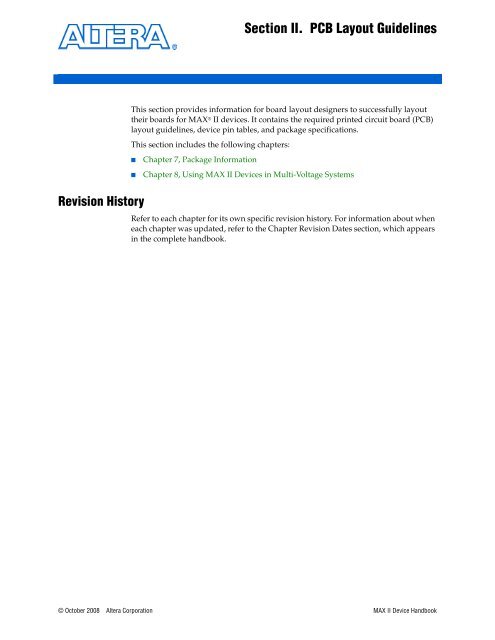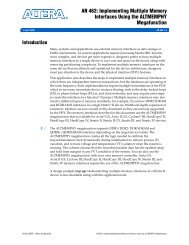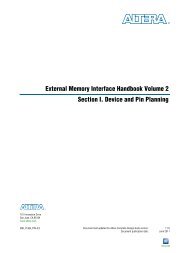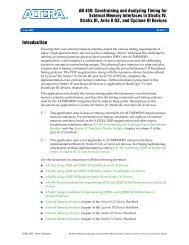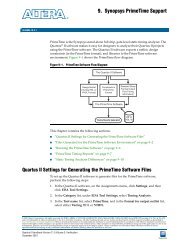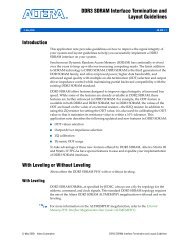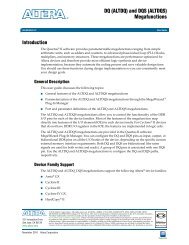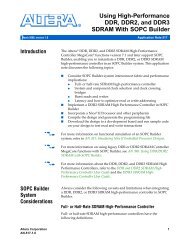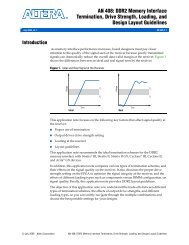Section II. PCB Layout Guidelines
Section II. PCB Layout Guidelines
Section II. PCB Layout Guidelines
Create successful ePaper yourself
Turn your PDF publications into a flip-book with our unique Google optimized e-Paper software.
Revision History<br />
<strong>Section</strong> <strong>II</strong>. <strong>PCB</strong> <strong>Layout</strong> <strong>Guidelines</strong><br />
This section provides information for board layout designers to successfully layout<br />
their boards for MAX ® <strong>II</strong> devices. It contains the required printed circuit board (<strong>PCB</strong>)<br />
layout guidelines, device pin tables, and package specifications.<br />
This section includes the following chapters:<br />
■ Chapter 7, Package Information<br />
■ Chapter 8, Using MAX <strong>II</strong> Devices in Multi-Voltage Systems<br />
Refer to each chapter for its own specific revision history. For information about when<br />
each chapter was updated, refer to the Chapter Revision Dates section, which appears<br />
in the complete handbook.<br />
© October 2008 Altera Corporation MAX <strong>II</strong> Device Handbook
<strong>II</strong>–2 <strong>Section</strong> <strong>II</strong>: <strong>PCB</strong> <strong>Layout</strong> <strong>Guidelines</strong><br />
Revision History<br />
MAX <strong>II</strong> Device Handbook © October 2008 Altera Corporation
M<strong>II</strong>51007-2.1<br />
Introduction<br />
7. Package Information<br />
This chapter provides package information for Altera’s MAX ® <strong>II</strong> devices, and includes<br />
these sections:<br />
■ “Board Decoupling <strong>Guidelines</strong>” on page 7–1<br />
■ “Device and Package Cross Reference” on page 7–1<br />
■ “Thermal Resistance” on page 7–2<br />
■ “Package Outlines” on page 7–3<br />
In this chapter, packages are listed in order of ascending pin count. See Figure 7–1<br />
through 7–17.<br />
Board Decoupling <strong>Guidelines</strong><br />
Decoupling requirements are based on the amount of logic used in the device and the<br />
output switching requirements. As the number of I/O pins and the capacitive load on<br />
the pins increase, more decoupling capacitance is required. As many as possible 0.1mF<br />
power-supply decoupling capacitors should be connected to the VCC and GND<br />
pins or the VCC and GND planes. These capacitors should be located as close as<br />
possible to the MAX <strong>II</strong> device. Each VCCINT/GNDINT and VCCIO/GNDIO pair should<br />
be decoupled with a 0.1-mF capacitor. When using high-density packages, such as<br />
ball-grid array (BGA) packages, it may not be possible to use one decoupling<br />
capacitor per VCC/GND pair. In this case, you should use as many decoupling<br />
capacitors as possible. For less dense designs, a reduction in the number of capacitors<br />
may be acceptable. Decoupling capacitors should have a good frequency response,<br />
such as monolithic-ceramic capacitors.<br />
Device and Package Cross Reference<br />
Table 7–1 shows which Altera ® MAX <strong>II</strong> devices are available in thin quad flat pack<br />
(TQFP), FineLine BGA (FBGA), and Micro Fineline BGA (MBGA) packages.<br />
Table 7–1. MAX <strong>II</strong> Devices in TQFP, FineLine BGA, and Micro FineLine BGA Packages (Part 1 of 2)<br />
Device Package Pin<br />
EPM240Z MBGA (1) 68<br />
EPM240<br />
EPM240G<br />
FBGA (1) 100<br />
EPM240<br />
EPM240G<br />
EPM240Z<br />
EPM240<br />
EPM240G<br />
MBGA (1) 100<br />
TQFP 100<br />
© October 2008 Altera Corporation MAX <strong>II</strong> Device Handbook
7–2 Chapter 7: Package Information<br />
Thermal Resistance<br />
EPM570<br />
EPM570G<br />
EPM570<br />
EPM570G<br />
EPM570Z<br />
EPM570<br />
EPM570G<br />
Thermal Resistance<br />
Table 7–1. MAX <strong>II</strong> Devices in TQFP, FineLine BGA, and Micro FineLine BGA Packages (Part 2 of 2)<br />
FBGA (1) 100<br />
MBGA (1) 100<br />
TQFP 100<br />
EPM570Z MBGA (1) 144<br />
EPM570<br />
EPM570G<br />
TQFP 144<br />
EPM570<br />
EPM570G<br />
EPM570<br />
EPM570G<br />
EPM570Z<br />
EPM1270<br />
EPM1270G<br />
EPM2210<br />
EPM2210G<br />
Note to Table 7–1:<br />
Device Package Pin<br />
(1) Packages available in lead-free versions only.<br />
FBGA 256<br />
MBGA (1) 256<br />
TQFP 144<br />
FBGA 256<br />
MBGA (1) 256<br />
FBGA 256<br />
FBGA 324<br />
Table 7–2 provides θ JA (junction-to-ambient thermal resistance) and θ JC (junction-tocase<br />
thermal resistance) values for Altera MAX <strong>II</strong> devices.<br />
Table 7–2. Thermal Resistance of MAX <strong>II</strong> Devices (Part 1 of 2)<br />
Device Pin Count Package θJC (°C/W)<br />
θJA (°C/W)<br />
Still Air<br />
θJA (°C/W)<br />
100 ft./min.<br />
θJA (°C/W)<br />
200 ft./min.<br />
θJA (°C/W)<br />
400 ft./min.<br />
EPM240Z 68 MBGA 35.5 68.7 63.0 60.9 59.2<br />
EPM240<br />
EPM240G<br />
100 FBGA 20.8 51.2 45.2 43.2 41.5<br />
EPM240<br />
EPM240G<br />
EPM240Z<br />
EPM240<br />
EPM240G<br />
EPM570<br />
EPM570G<br />
100 MBGA 32.1 53.8 47.7 45.7 44.0<br />
100 TQFP 12.0 39.5 37.5 35.5 31.6<br />
100 FBGA 14.8 42.8 36.8 34.9 33.3<br />
MAX <strong>II</strong> Device Handbook © October 2008 Altera Corporation
Chapter 7: Package Information 7–3<br />
Package Outlines<br />
Table 7–2. Thermal Resistance of MAX <strong>II</strong> Devices (Part 2 of 2)<br />
Device Pin Count Package θ JC (°C/W)<br />
EPM570<br />
EPM570G<br />
EPM570Z<br />
EPM570<br />
EPM570G<br />
Package Outlines<br />
100 MBGA 25.0 46.5 40.4 38.4 36.8<br />
100 TQFP 11.2 38.7 36.6 34.6 30.8<br />
EPM570Z 144 MBGA 20.2 51.8 45.1 43.2 41.5<br />
EPM570<br />
EPM570G<br />
144 TQFP 10.5 32.1 30.3 28.7 26.1<br />
EPM570<br />
EPM570G<br />
EPM570<br />
EPM570G<br />
EPM570Z<br />
EPM1270<br />
EPM1270G<br />
EPM2210<br />
EPM2210G<br />
θ JA (°C/W)<br />
Still Air<br />
256 FBGA 13.0 37.4 33.1 30.5 28.4<br />
256 MBGA 12.9 39.5 33.6 31.6 30.1<br />
144 TQFP 10.5 31.4 29.7 28.2 25.8<br />
256 FBGA 10.4 33.5 29.3 26.8 24.7<br />
256 MBGA 10.6 36.1 30.2 28.3 26.8<br />
256 FBGA 8.7 30.2 26.1 23.6 21.7<br />
324 FBGA 8.2 29.8 25.7 23.3 21.3<br />
The package outlines on the following pages are listed in order of ascending pin<br />
count. Altera package outlines meet the requirements of JEDEC Publication No. 95.<br />
68-Pin Micro FineLine Ball-Grid Array (MBGA) – Wire Bond<br />
■ All dimensions and tolerances conform to ASME Y14.5M – 1994<br />
■ Controlling dimension is in millimeters<br />
θ JA (°C/W)<br />
100 ft./min.<br />
θ JA (°C/W)<br />
200 ft./min.<br />
θ JA (°C/W)<br />
400 ft./min.<br />
■ Pin A1 may be indicated by an ID dot, or a special feature, in its proximity on<br />
package surface<br />
Package Information (Part 1 of 2) Package Outline Dimension Table (Part 1 of 2)<br />
Description Specification<br />
Millimeters<br />
Symbol<br />
Ordering Code Reference M Min. Nom. Max.<br />
Package Acronym MBGA A — — 1.20<br />
Substrate Material BT A1 0.15 — —<br />
Solder Ball Composition Pb-free: Sn:3Ag:0.5Cu (Typ.) A2 — — 1.00<br />
JEDEC Outline Reference MO-195 Variation: AB A3 0.60 REF<br />
© October 2008 Altera Corporation MAX <strong>II</strong> Device Handbook
7–4 Chapter 7: Package Information<br />
Package Outlines<br />
Package Information (Part 2 of 2) Package Outline Dimension Table (Part 2 of 2)<br />
Maximum Lead<br />
Coplanarity<br />
0.003 inches (0.08 mm)<br />
D 5.00 BSC<br />
Weight 0.1 g E 5.00 BSC<br />
Moisture Sensitivity Level<br />
Printed on moisture barrier<br />
bag<br />
Figure 7–1. 68-Pin Micro FineLine BGA Package Outline<br />
Pin A1 ID<br />
TOP VIEW<br />
D<br />
A1<br />
E<br />
A2<br />
A3<br />
A<br />
b 0.25 0.30 0.35<br />
e 0.50 BSC<br />
BOTTOM VIEW<br />
MAX <strong>II</strong> Device Handbook © October 2008 Altera Corporation<br />
e<br />
9 8 7 6 5 4 3 2 1<br />
b e<br />
A<br />
B<br />
C<br />
D<br />
E<br />
F<br />
G<br />
H<br />
J<br />
Pin A1<br />
Corner
Chapter 7: Package Information 7–5<br />
Package Outlines<br />
100-Pin Plastic Thin Quad Flat Pack (TQFP)<br />
■ All dimensions and tolerances conform to ANSI Y14.5M – 1994<br />
■ Controlling dimension is in millimeters<br />
■ Pin 1 may be indicated by an ID dot, or a special feature, in its proximity on<br />
package surface<br />
Package Information Package Outline Dimension Table<br />
Description Specification<br />
Millimeters<br />
Symbol<br />
Ordering Code Reference T Min. Nom. Max.<br />
Package Acronym TQFP A — — 1.20<br />
Leadframe Material Copper A1 0.05 — 0.15<br />
Lead Finish (Plating)<br />
Regular: 85Sn:15Pb (Typ.)<br />
Pb-free: Matte Sn<br />
A2 0.95 1.00 1.05<br />
D 16.00 BSC<br />
JEDEC Outline Reference MS-026 Variation: AED D1 14.00 BSC<br />
Maximum Lead<br />
Coplanarity<br />
0.003 inches (0.08mm)<br />
E 16.00 BSC<br />
Weight 0.6 g E1 14.00 BSC<br />
Moisture Sensitivity Level<br />
Printed on moisture barrier<br />
bag<br />
L 0.45 0.60 0.75<br />
L1 1.00 REF<br />
S 0.20 — —<br />
b 0.17 0.22 0.27<br />
c 0.09 — 0.20<br />
e 0.50 BSC<br />
θ 0° 3.5° 7°<br />
© October 2008 Altera Corporation MAX <strong>II</strong> Device Handbook
7–6 Chapter 7: Package Information<br />
Package Outlines<br />
Figure 7–2. 100-Pin TQFP Package Outline<br />
Pin 1<br />
Pin 25<br />
Pin 100<br />
Pin 1 ID<br />
D<br />
D1<br />
See Detail A<br />
MAX <strong>II</strong> Device Handbook © October 2008 Altera Corporation<br />
e<br />
b<br />
E1<br />
A1<br />
E<br />
A2 A<br />
DETAIL A<br />
C<br />
S<br />
L<br />
L1<br />
0.25mm<br />
Gage<br />
Plane
Chapter 7: Package Information 7–7<br />
Package Outlines<br />
100-Pin Micro FineLine Ball-Grid Array (MBGA)<br />
■ All dimensions and tolerances conform to ASME Y14.5 – 1994.<br />
■ Controlling dimension is in millimeters.<br />
■ Pin A1 may be indicated by an ID dot, or a special feature, in its proximity on<br />
package surface<br />
Package Information Package Outline Dimension Table<br />
Description Specification<br />
Millimeters<br />
Symbol<br />
Ordering Code Reference M Min. Nom. Max.<br />
Package Acronym MBGA A — — 1.20<br />
Substrate Material BT A1 0.15 — —<br />
Solder Ball Composition Pb-free: Sn:3Ag:0.5Cu (Typ.) A2 — — 1.00<br />
JEDEC Outline Reference MO-195 Variation: AC A3 0.60 REF<br />
Maximum Lead<br />
Coplanarity<br />
0.003 inches (0.08 mm)<br />
D 6.00 BSC<br />
Weight 0.1 g E 6.00 BSC<br />
Moisture Sensitivity Level<br />
Printed on moisture barrier<br />
bag<br />
b 0.25 0.30 0.35<br />
e 0.50 BSC<br />
© October 2008 Altera Corporation MAX <strong>II</strong> Device Handbook
7–8 Chapter 7: Package Information<br />
Package Outlines<br />
Figure 7–3. 100-Pin Micro FineLine BGA Package Outline<br />
Pin A1 ID<br />
TOP VIEW<br />
D<br />
100-Pin FineLine Ball-Grid Array (FBGA)<br />
A1<br />
E<br />
A3<br />
■ All dimensions and tolerances conform to ASME Y14.5 – 1994<br />
■ Controlling dimension is in millimeters<br />
BOTTOM VIEW<br />
■ Pin A1 may be indicated by an ID dot, or a special feature, in its proximity on<br />
package surface<br />
Package Information Package Outline Dimension Table<br />
Description Specification<br />
Millimeters<br />
Symbol<br />
Ordering Code Reference F Min. Nom. Max.<br />
Package Acronym FBGA A — — 1.55<br />
Substrate Material BT A1 0.25 — —<br />
MAX <strong>II</strong> Device Handbook © October 2008 Altera Corporation<br />
A2<br />
A<br />
e<br />
11<br />
10<br />
9 8 7 6 5 4 3 2 1<br />
b<br />
e<br />
A<br />
B<br />
C<br />
D<br />
E<br />
F<br />
G<br />
H<br />
J<br />
K<br />
L<br />
Pin A1<br />
Corner
Chapter 7: Package Information 7–9<br />
Package Outlines<br />
Package Information Package Outline Dimension Table<br />
Solder Ball Composition<br />
Regular: 63Sn:37Pb (Typ.)<br />
Pb-free: Sn:3Ag:0.5Cu (Typ.)<br />
A2 1.05 REF<br />
A3 — — 0.80<br />
JEDEC Outline Reference MO-192 Variation: DAC-1 D 11.00 BSC<br />
Maximum Lead<br />
Coplanarity<br />
0.008 inches (0.20 mm)<br />
E 11.00 BSC<br />
Weight 0.6 g b 0.45 0.50 0.55<br />
Moisture Sensitivity Level<br />
Printed on moisture barrier<br />
bag<br />
Figure 7–4. 100-Pin FineLine BGA Package Outline<br />
Pin A1 ID<br />
TOP VIEW<br />
D<br />
E<br />
A1<br />
A3<br />
e 1.00 BSC<br />
BOTTOM VIEW<br />
© October 2008 Altera Corporation MAX <strong>II</strong> Device Handbook<br />
A2<br />
e<br />
A<br />
10<br />
9 8 7 6 5 4 3 2 1<br />
b e<br />
A<br />
B<br />
C<br />
D<br />
E<br />
F<br />
G<br />
H<br />
J<br />
K<br />
Pin A1<br />
Corner
7–10 Chapter 7: Package Information<br />
Package Outlines<br />
144-Pin Plastic Thin Quad Flat Pack (TQFP)<br />
■ All dimensions and tolerances conform to ANSI Y14.5M – 1994<br />
■ Controlling dimension is in millimeters<br />
■ Pin 1 may be indicated by an ID dot, or a special feature, in its proximity on<br />
package surface<br />
Package Information Package Outline Figure Reference<br />
Description Specification<br />
Millimeters<br />
Symbol<br />
Ordering Code Reference T Min. Nom. Max.<br />
Package Acronym TQFP A — — 1.60<br />
Leadframe Material Copper A1 0.05 — 0.15<br />
Lead Finish (Plating)<br />
Regular: 85Sn:15Pb (Typ.)<br />
Pb-free: Matte Sn<br />
A2 1.35 1.40 1.45<br />
D 22.00 BSC<br />
JEDEC Outline Reference MS-026 Variation: BFB D1 20.00 BSC<br />
Maximum Lead<br />
Coplanarity<br />
0.003 inches (0.08 mm)<br />
E 22.00 BSC<br />
Weight 1.1 g E1 20.00 BSC<br />
Moisture Sensitivity Level<br />
Printed on moisture barrier<br />
bag<br />
L 0.45 0.60 0.75<br />
L1 1.00 REF<br />
S 0.20 — —<br />
b 0.17 0.22 0.27<br />
c 0.09 — 0.20<br />
e 0.50 BSC<br />
θ 0° 3.5° 7°<br />
MAX <strong>II</strong> Device Handbook © October 2008 Altera Corporation
Chapter 7: Package Information 7–11<br />
Package Outlines<br />
Figure 7–5. 144-Pin TQFP Package Outline<br />
Pin 1<br />
Pin 36<br />
Pin 144<br />
Pin 1 ID<br />
D<br />
D1<br />
See Detail A<br />
© October 2008 Altera Corporation MAX <strong>II</strong> Device Handbook<br />
A1<br />
E1<br />
e<br />
b<br />
A2<br />
E<br />
A<br />
DETAIL A<br />
C<br />
S<br />
L<br />
L1<br />
0.25mm<br />
Gage<br />
Plane
7–12 Chapter 7: Package Information<br />
Package Outlines<br />
144-Pin Micro FineLine Ball-Grid Array (MBGA) – Wire Bond<br />
■ All dimensions and tolerances conform to ASME Y14.5M – 1994.<br />
■ Controlling dimension is in millimeters.<br />
■ Pin A1 may be indicated by an ID dot, or a special feature, in its proximity on<br />
package surface<br />
Package Information Package Outline Dimension Table<br />
Description Specification<br />
Millimeters<br />
Symbol<br />
Ordering Code Reference M Min. Nom. Max.<br />
Package Acronym MBGA A — — 1.20<br />
Substrate Material BT A1 0.15 — —<br />
Solder Ball Composition Pb-free: Sn:3Ag:0.5Cu (Typ.) A2 — — 1.00<br />
JEDEC Outline Reference MO-195 Variation: AD A3 0.60 REF<br />
Maximum Lead<br />
Coplanarity<br />
0.003 inches (0.08 mm)<br />
D 7.00 BSC<br />
Weight 0.1 g E 7.00 BSC<br />
Moisture Sensitivity Level<br />
Printed on moisture barrier<br />
bag<br />
b 0.25 0.30 0.35<br />
e 0.50 BSC<br />
MAX <strong>II</strong> Device Handbook © October 2008 Altera Corporation
Chapter 7: Package Information 7–13<br />
Package Outlines<br />
Figure 7–6. 144-Pin Micro FineLine BGA Package Outline<br />
Pin A1 ID<br />
TOP VIEW<br />
D<br />
256-Pin Micro FineLine Ball-Grid Array (MBGA)<br />
■ All dimensions and tolerances conform to ASME Y14.5 – 1994<br />
■ Controlling dimension is in millimeters<br />
A1<br />
E<br />
A3<br />
BOTTOM VIEW<br />
■ Pin A1 may be indicated by an ID dot, or a special feature, in its proximity on<br />
package surface<br />
© October 2008 Altera Corporation MAX <strong>II</strong> Device Handbook<br />
A2<br />
e<br />
A<br />
13<br />
12<br />
11<br />
10<br />
9 8 7 6 5 4 3 2 1<br />
b e<br />
Package Information (Part 1 of 2) Package Outline Dimension Table (Part 1 of 2)<br />
Description Specification<br />
Millimeters<br />
Symbol<br />
Ordering Code Reference M Min. Nom. Max.<br />
Package Acronym MBGA A — — 1.20<br />
Substrate Material BT A1 0.15 — —<br />
Solder Ball Composition Pb-free: Sn:3Ag:0.5Cu (Typ.) A2 — — 1.00<br />
JEDEC Outline Reference MO-192 Variation: BH A3 0.60 REF<br />
Maximum Lead<br />
Coplanarity<br />
0.003 inches (0.08 mm)<br />
D 11.00 BSC<br />
Weight 0.3 g E 11.00 BSC<br />
A<br />
B<br />
C<br />
D<br />
E<br />
F<br />
G<br />
H<br />
J<br />
K<br />
L<br />
M<br />
N<br />
Pin A1<br />
Corner
7–14 Chapter 7: Package Information<br />
Package Outlines<br />
Package Information (Part 2 of 2) Package Outline Dimension Table (Part 2 of 2)<br />
Moisture Sensitivity Level<br />
Printed on moisture barrier<br />
bag<br />
Figure 7–7. 256-Pin Micro FineLine BGA Package Outline<br />
Pin A1 ID<br />
TOP VIEW<br />
D<br />
A1<br />
E<br />
A<br />
A2<br />
A3<br />
b 0.25 0.30 0.35<br />
e 0.50 BSC<br />
BOTTOM VIEW<br />
MAX <strong>II</strong> Device Handbook © October 2008 Altera Corporation<br />
e<br />
b<br />
e<br />
Pin A1<br />
Corner
Chapter 7: Package Information 7–15<br />
Package Outlines<br />
256-Pin FineLine Ball-Grid Array (FBGA)<br />
■ All dimensions and tolerances conform to ANSI Y14.5M – 1994<br />
■ Controlling dimension is in millimeters<br />
■ Pin A1 may be indicated by an ID dot, or a special feature, in its proximity on<br />
package surface<br />
Package Information Package Outline Dimension Table<br />
Description Specification Millimeters<br />
Ordering Code Reference F Min. Nom. Max.<br />
Package Acronym FBGA A — — 2.20<br />
Substrate Material BT A1 0.30 — —<br />
Solder Ball Composition<br />
Regular: 63Sn:37Pb (Typ.)<br />
Pb-free: Sn:3Ag:0.5Cu (Typ.)<br />
A2 — — 1.80<br />
A3 0.70 REF<br />
JEDEC Outline Reference MS-034 Variation: AAF-1 D 17.00 BSC<br />
Maximum Lead<br />
Coplanarity<br />
0.008 inches (0.20 mm)<br />
E 17.00 BSC<br />
Weight 1.5 g b 0.50 0.60 0.70<br />
Moisture Sensitivity Level<br />
Printed on moisture barrier<br />
bag<br />
e 1.00 BSC<br />
© October 2008 Altera Corporation MAX <strong>II</strong> Device Handbook
7–16 Chapter 7: Package Information<br />
Package Outlines<br />
Figure 7–8. 256-Pin FineLine BGA Package Outline<br />
Pin A1 ID<br />
TOP VIEW<br />
324-Pin FineLine Ball-Grid Array (FBGA)<br />
D<br />
A1<br />
E<br />
A3<br />
A2<br />
A<br />
■ All dimensions and tolerances conform to ANSI Y14.5M – 1994<br />
■ Controlling dimension is in millimeters<br />
b e<br />
■ Pin A1 may be indicated by an ID dot, or a special feature, in its proximity on<br />
package surface<br />
MAX <strong>II</strong> Device Handbook © October 2008 Altera Corporation<br />
e<br />
BOTTOM VIEW<br />
Package Information (Part 1 of 2) Package Outline Dimension Table (Part 1 of 2)<br />
Description Specification<br />
Millimeters<br />
Symbol<br />
Ordering Code Reference F Min. Nom. Max.<br />
Package Acronym FBGA A — — 2.20<br />
Substrate Material BT A1 0.30 — —<br />
Solder Ball Composition<br />
Regular: 63Sn:37Pb (Typ.)<br />
Pb-free: Sn:3Ag:0.5Cu (Typ.)<br />
A2 — — 1.80<br />
A3 0.70 REF<br />
JEDEC Outline Reference MS-034 Variation: AAG-1 D 19.00 BSC<br />
Maximum Lead<br />
Coplanarity<br />
0.008 inches (0.20 mm)<br />
E 19.00 BSC<br />
Weight 1.6 g b 0.50 0.60 0.70<br />
Pin A1<br />
Corner
Chapter 7: Package Information 7–17<br />
Package Outlines<br />
Package Information (Part 2 of 2) Package Outline Dimension Table (Part 2 of 2)<br />
Moisture Sensitivity Level<br />
Printed on moisture barrier<br />
bag<br />
Figure 7–9. 324-Pin FineLine BGA Package Outline<br />
Pin A1 ID<br />
TOP VIEW<br />
D<br />
A1<br />
E<br />
A3<br />
A2 A<br />
e 1.00 BSC<br />
© October 2008 Altera Corporation MAX <strong>II</strong> Device Handbook<br />
e<br />
b<br />
BOTTOM VIEW<br />
e<br />
Pin A1<br />
Corner
7–18 Chapter 7: Package Information<br />
Document Revision History<br />
Document Revision History<br />
Table 7–3 shows the revision history for this chapter.<br />
Table 7–3. Document Revision History<br />
Date and Revision Changes Made Summary of Changes<br />
October 2008,<br />
version 2.1<br />
■ Updated New Document Format. —<br />
December 2007,<br />
■ Updated Table 7–1 and Table 7–2.<br />
■ Updated document with<br />
version 2.0<br />
■ Added “68-Pin Micro FineLine Ball-Grid Array (MBGA) –<br />
MAX <strong>II</strong>Z information.<br />
Wire Bond” and “144-Pin Micro FineLine Ball-Grid Array ■ Added information about<br />
(MBGA) – Wire Bond” sections.<br />
68-Pin Micro FineLine<br />
■ Replaced Figure 7–9 with correct diagram.<br />
Ball-Grid Array and 144-<br />
Pin Micro FineLine<br />
Ball-Grid Array.<br />
December 2006,<br />
version 1.4<br />
■ Added document revision history. —<br />
July 2006,<br />
version 1.3<br />
■ Updated packaging information. —<br />
August 2005,<br />
■ Updated the 100-pin plastic thin quad flat pack (TQFP)<br />
—<br />
version 1.2<br />
information.<br />
December 2004,<br />
■ Updated Board Decoupling <strong>Guidelines</strong> section (changed<br />
—<br />
version 1.1<br />
the 0.2 value to 0.1.)<br />
MAX <strong>II</strong> Device Handbook © October 2008 Altera Corporation
M<strong>II</strong>51009-1.7<br />
Introduction<br />
8. Using MAX <strong>II</strong> Devices in Multi-Voltage<br />
Systems<br />
Technological advancements in deep submicron processes have lowered the supply<br />
voltage levels of semiconductor devices, creating a design environment where devices<br />
on a system board may potentially use many different supply voltages such as 5.0, 3.3,<br />
2.5, 1.8, and 1.5 V, which can ultimately lead to voltage conflicts.<br />
To accommodate interfacing with a variety of devices on system boards, MAX ® <strong>II</strong><br />
devices have MultiVolt I/O interfaces that allow devices in a mixed-voltage design<br />
environment to communicate directly with MAX <strong>II</strong> devices. The MultiVolt interface<br />
separates the power supply voltage (V CCINT) from the output voltage (V CCIO), enabling<br />
MAX <strong>II</strong> devices to interface with other devices using a different voltage level on the<br />
same printed circuit board (<strong>PCB</strong>).<br />
Additionally, the MAX <strong>II</strong> device family supports the MultiVolt core feature. For 1.8-V<br />
operation, use the MAX <strong>II</strong>G or MAX <strong>II</strong>Z devices. The 1.8-V input directly powers the<br />
core of the devices. For 2.5-V or 3.3-V operation, use the MAX <strong>II</strong> devices. MAX <strong>II</strong><br />
devices that support 2.5-V and 3.3-V operation have an internal voltage regulator that<br />
regulates at 1.8 V.<br />
This chapter discusses several features that allow you to implement Altera ® devices in<br />
multiple-voltage systems without damaging the device or the system, including:<br />
■ Hot Socketing—Insert or remove MAX <strong>II</strong> devices to and from a powered-up<br />
system without affecting the device or system operation<br />
■ Power-Up Sequence Flexibility—MAX <strong>II</strong> devices can accommodate any possible<br />
power-up sequence<br />
■ Power-On Reset—MAX <strong>II</strong> devices maintain a reset state until voltage is within<br />
operating range<br />
This chapter contains the following sections:<br />
■ “I/O Standards” on page 8–2<br />
■ “MultiVolt Core and I/O Operation” on page 8–3<br />
■ “5.0-V Device Compatibility” on page 8–3<br />
■ “Recommended Operating Condition for 5.0-V Compatibility” on page 8–7<br />
■ “Hot Socketing” on page 8–8<br />
■ “Power-Up Sequencing” on page 8–8<br />
■ “Power-On Reset” on page 8–8<br />
© October 2008 Altera Corporation MAX <strong>II</strong> Device Handbook
8–2 Chapter 8: Using MAX <strong>II</strong> Devices in Multi-Voltage Systems<br />
I/O Standards<br />
I/O Standards<br />
The I/O buffer of MAX <strong>II</strong> devices is programmable and supports a wide range of I/O<br />
voltage standards. Each I/O bank in a MAX <strong>II</strong> device can be programmed to comply<br />
with a different I/O standard. All I/O banks can be configured with the following<br />
standards:<br />
■ 3.3-V LVTTL/LVCMOS<br />
■ 2.5-V LVTTL/LVCMOS<br />
■ 1.8-V LVTTL/LVCMOS<br />
■ 1.5-V LVCMOS<br />
The Schmitt trigger input option is supported by the 3.3-V and 2.5-V I/O standards.<br />
The I/O Bank 3 also includes 3.3-V PCI I/O standard interface capability on the<br />
EPM1270 and EPM2210 devices. See Figure 8–1.<br />
Figure 8–1. I/O Standards Supported by MAX <strong>II</strong> Device (Note 1), (2), (3), (4), (5)<br />
I/O Bank 1<br />
Notes to Figure 8–1:<br />
(1) Figure 8–1 is a top view of the silicon die.<br />
I/O Bank 2<br />
All I/O Banks support<br />
■ 3.3-V LVTTL/LVCMOS<br />
■ 2.5-V LVTTL/LVCMOS<br />
■ 1.8-V LVTTL/LVCMOS<br />
■ 1.5-V LVCMOS<br />
I/O Bank 4<br />
Individual<br />
Power Bus<br />
(2) Figure 8–1 is a graphical representation only. Refer to the pin list and the Quartus ® <strong>II</strong> software for exact pin locations.<br />
(3) EPM240 and EPM570 devices only have two I/O banks.<br />
(4) The 3.3-V PCI I/O standard is only supported in EPM1270 and EPM2210 devices.<br />
(5) The Schmitt trigger input option for 3.3-V and 2.5-V I/O standards is supported for all I/O pins.<br />
I/O Bank 3<br />
also supports<br />
the 3.3-V PCI<br />
I/O Standard<br />
I/O Bank 3<br />
MAX <strong>II</strong> Device Handbook © October 2008 Altera Corporation
Chapter 8: Using MAX <strong>II</strong> Devices in Multi-Voltage Systems 8–3<br />
MultiVolt Core and I/O Operation<br />
MultiVolt Core and I/O Operation<br />
5.0-V Device Compatibility<br />
MAX <strong>II</strong> devices include MultiVolt core I/O operation capability, allowing the core and<br />
I/O blocks of the device to be powered-up with separate supply voltages. The<br />
VCCINT pins supply power to the device core and the VCCIO pins supply power to<br />
the device I/O buffers. The VCCINT pins can be powered-up with 1.8 V for MAX <strong>II</strong>G<br />
and MAX <strong>II</strong>Z devices or 2.5/3.3 V for MAX <strong>II</strong> devices. All the VCCIO pins for a given<br />
I/O bank that have MultiVolt capability should be supplied from the same voltage<br />
level (for example, 5.0, 3.3, 2.5, 1.8, or 1.5 V). See Figure 8–2.<br />
Figure 8–2. Implementing a Multiple-Voltage System with a MAX <strong>II</strong> Device (Note 1), (2), (3), (4)<br />
Notes to Figure 8–2:<br />
5.0-V<br />
Device<br />
1.8 V/2.5 V/3.3 V<br />
Power Supply<br />
VCCIO MAX <strong>II</strong><br />
Device<br />
VCCIO 2.5-V<br />
Device<br />
3.3-V<br />
Device<br />
(1) For MAX <strong>II</strong>G and MAX <strong>II</strong>Z devices, VCCINT pins will only accept a 1.8-V power supply.<br />
(2) For MAX <strong>II</strong> devices, VCCINT pins will only accept a 2.5-V or 3.3-V power supply.<br />
(3) MAX <strong>II</strong> devices can drive a 5.0-V TTL input when VCCIO = 3.3 V. To drive a 5.0-V CMOS, an open-drain setting with<br />
internal I/O clamp diode and external resistor are required.<br />
(4) MAX <strong>II</strong> devices can be 5.0-V tolerant with the use of an external resistor and the internal I/O clamp diode on EPM1270<br />
and EPM2210 devices.<br />
A MAX <strong>II</strong> device can drive a 5.0-V TTL device by connecting the V CCIO pins of the<br />
MAX <strong>II</strong> device to 3.3 V. This is possible because the output high voltage (V OH) of a 3.3-<br />
V interface meets the minimum high-level voltage of 2.4 V of a 5.0-V TTL device.<br />
A MAX <strong>II</strong> device may not correctly interoperate with a 5.0-V CMOS device if the<br />
output of the MAX <strong>II</strong> device is connected directly to the input of the 5.0-V CMOS<br />
device. If the MAX <strong>II</strong> device‘s V OUT is greater than V CCIO, the PMOS pull-up transistor<br />
still conducts if the pin is driving high, preventing an external pull-up resistor from<br />
pulling the signal to 5.0 V. To make MAX <strong>II</strong> device outputs compatible with 5.0-V<br />
CMOS devices, configure the output pins as open-drain pins with the I/O clamp<br />
diode enabled, and use an external pull-up resistor. See Figure 8–3.<br />
© October 2008 Altera Corporation MAX <strong>II</strong> Device Handbook<br />
V CCINT<br />
V CCIO
8–4 Chapter 8: Using MAX <strong>II</strong> Devices in Multi-Voltage Systems<br />
5.0-V Device Compatibility<br />
Figure 8–3. MAX <strong>II</strong> Device Compatibility with 5.0-V CMOS Devices<br />
Note to Figure 8–3:<br />
Model as R INT<br />
V IN<br />
3.3 V<br />
(1) This diode is only active after power-up. MAX <strong>II</strong> devices require an external diode if driven by 5.0 V before power-up.<br />
The open-drain pin never drives high, only low or tri-state. When the open-drain pin<br />
is active, it drives low. When the open-drain pin is inactive, the pin is tri-stated and<br />
the trace pulls up to 5.0 V by the external resistor. The purpose of enabling the I/O<br />
clamp diode is to protect the MAX <strong>II</strong> device’s I/O pins. The 3.3-V V CCIO supplied to the<br />
I/O clamp diodes causes the voltage at point A to clamp at 4.0 V, which meets the<br />
MAX <strong>II</strong> device’s reliability limits when the trace voltage exceeds 4.0 V. The device<br />
operates successfully because a 5.0-V input is within its input specification.<br />
1 The I/O clamp diode is only supported in the EPM1270 and EPM2210 devices’ I/O<br />
Bank 3. An external protection diode is needed for other I/O banks in EPM1270 and<br />
EPM2210 devices and all I/O pins in EPM240 and EPM570 devices.<br />
The pull-up resistor value should be small enough for sufficient signal rise time, but<br />
large enough so that it does not violate the I OL (output low) specification of MAX <strong>II</strong><br />
devices.<br />
The maximum MAX <strong>II</strong> device I OL depends on the programmable drive strength of the<br />
I/O output. Table 8–1 shows the programmable drive strength settings that are<br />
available for the 3.3-V LVTTL/LVCMOS I/O standard for MAX <strong>II</strong> devices. The<br />
Quartus <strong>II</strong> software uses the maximum current strength as the default setting. The PCI<br />
I/O standard is always set at 20 mA with no alternate setting.<br />
MAX <strong>II</strong> Device Handbook © October 2008 Altera Corporation<br />
V CCIO<br />
Open Drain<br />
VSS<br />
V OUT<br />
(1)<br />
V CCIO<br />
A<br />
V CCIO<br />
Table 8–1. 3.3-V LVTTL/LVCMOS Programmable Drive Strength<br />
R EXT<br />
5.0 V ± 0.5 V<br />
5.0-V CMOS<br />
Device<br />
I/O Standard IOH/IOL Current Strength Setting (mA)<br />
3.3-V LVTTL 16<br />
8<br />
3.3-V LVCMOS 8<br />
4
Chapter 8: Using MAX <strong>II</strong> Devices in Multi-Voltage Systems 8–5<br />
5.0-V Device Compatibility<br />
To compute the required value of R EXT, first calculate the model of the open-drain<br />
transistors on the MAX <strong>II</strong> device. This output resistor (R EXT) can be modeled by<br />
dividing V OL by I OL (R EXT = V OL/I OL). Table 8–2 shows the maximum V OL for the 3.3-V<br />
LVTTL/LVCMOS I/O standard for MAX <strong>II</strong> devices.<br />
f For more information about I/O standard specifications, refer to the DC and Switching<br />
Characteristics chapter in the MAX <strong>II</strong> Device Handbook.<br />
Table 8–2. 3.3-V LVTTL/LVCMOS Maximum V OL<br />
I/O Standard Voltage (V)<br />
3.3-V LVTTL 0.45<br />
3.3-V LVCMOS 0.20<br />
Select R EXT so that the MAX <strong>II</strong> device’s I OL specification is not violated. You can<br />
compute the required pull-up resistor value of R EXT by using the equation: R EXT =<br />
(V CC/I OL) – R INT. For example, if an I/O pin is configured as a 3.3-V LVTTL with a 16<br />
mA drive strength, given that the maximum power supply (V CC) is 5.5 V, the value of<br />
R EXT can be calculated as follows:<br />
Equation 8–1.<br />
R EXT<br />
=<br />
(<br />
--------------------------------------<br />
5.5 V – 0.45 V)<br />
=<br />
315.6 Ω<br />
16 mA<br />
This resistor value computation assumes worst-case conditions. You can adjust the<br />
R EXT value according to the device configuration drive strength. Additionally, if your<br />
system does not see a wide variation in voltage-supply levels, you can adjust these<br />
calculations accordingly.<br />
Because MAX <strong>II</strong> devices are 3.3-V, 32-bit, 66-MHz PCI compliant, the input circuitry<br />
accepts a maximum high-level input voltage (V IH) of 4.0 V. To drive a MAX <strong>II</strong> device<br />
with a 5.0-V device, you must connect a resistor (R 2) between the MAX <strong>II</strong> device and<br />
the 5.0-V device. See Figure 8–4.<br />
© October 2008 Altera Corporation MAX <strong>II</strong> Device Handbook
8–6 Chapter 8: Using MAX <strong>II</strong> Devices in Multi-Voltage Systems<br />
5.0-V Device Compatibility<br />
Figure 8–4. Driving a MAX <strong>II</strong> PCI-Compliant Device with a 5.0-V Device<br />
5.0 V ± 0.5 V<br />
Model as R 1<br />
Note to Figure 8–4:<br />
5.0-V Device<br />
V CC<br />
(1) This diode is only active after power-up. MAX <strong>II</strong> devices require an external diode if driven by 5.0 V before power-up.<br />
If V CCIO for MAX <strong>II</strong> devices is 3.3 V and the I/O clamp diode is enabled, the voltage at point B in<br />
Figure 8–4 is 4.0 V, which meets the MAX <strong>II</strong> devices reliability limits when the trace voltage<br />
exceeds 4.0 V. To limit large current draw from the 5.0-V device, R 2 should be small enough for<br />
a fast signal rise time and large enough so that it does not violate the high-level output current<br />
(I OH) specifications of the devices driving the trace.<br />
To compute the required value of R2, first calculate the model of the pull-up transistors on the<br />
5.0-V device. This output resistor (R1) can be modeled by dividing the 5.0-V device supply<br />
voltage (VCC) by the IOH: R1 = VCC/IOH Figure 8–5 shows an example of typical output drive characteristics of a 5.0-V device.<br />
Figure 8–5. Output Drive Characteristics of a 5.0-v Device<br />
Typical IO Output<br />
Current (mA)<br />
I<br />
150<br />
135<br />
120<br />
90<br />
60<br />
30<br />
MAX <strong>II</strong> Device Handbook © October 2008 Altera Corporation<br />
R 2<br />
1<br />
2<br />
PCI Clamp<br />
I OH<br />
I OL<br />
V = 5.0 V<br />
CCINT<br />
V = 5.0 V<br />
CCIO<br />
3<br />
V O Output Voltage (V)<br />
I<br />
MAX <strong>II</strong> Device<br />
V CCIO<br />
4<br />
B<br />
(1)<br />
5<br />
3.3 V<br />
V CCIO
Chapter 8: Using MAX <strong>II</strong> Devices in Multi-Voltage Systems 8–7<br />
Recommended Operating Condition for 5.0-V Compatibility<br />
As shown above, R 1 = 5.0 V/135 mA.<br />
The values usually shown in data sheets reflect typical operating conditions. Subtract<br />
20% from the data sheet value for guard band. This subtraction applied to the above<br />
example gives R 1 a value of 30.<br />
Select R2 so that the MAX <strong>II</strong> device’s IOH specification is not violated. For example, if<br />
the above device has a maximum IOH of 8 mA, given the I/O clamp diode, VIN = VCCIO + 0.7 V = 3.7 V. Given that the maximum supply load of a 5.0-V device (VCC) is 5.5 V,<br />
the value of R2 can be calculated as follows:<br />
Equation 8–2.<br />
R 2<br />
=<br />
(<br />
-------------------------------------------------------------------------------<br />
5.5 V – 3.7 V)<br />
– ( 8 mA × 30 Ω)<br />
= 194 Ω<br />
8 mA<br />
This analysis assumes worst-case conditions. If your system does not see a wide<br />
variation in voltage-supply levels, you can adjust these calculations accordingly.<br />
Because 5.0-V device tolerance in MAX <strong>II</strong> devices requires use of the I/O clamp, and<br />
this clamp is activated only after power-up, 5.0-V signals may not be driven into the<br />
device until it is configured. The I/O clamp diode is only supported in the EPM1270<br />
and EPM2210 devices’ I/O Bank 3. An external protection diode is needed for other<br />
I/O banks for EPM1270 and EPM2210 devices and all I/O pins in EPM240 and<br />
EPM570 devices.<br />
Recommended Operating Condition for 5.0-V Compatibility<br />
As mentioned earlier, a 5.0-V tolerance can be supported with the I/O clamp diode<br />
enabled with external series/pull-up resistance. To guarantee long term reliability of<br />
the device’s I/O buffer, there are restrictions on the signal duty cycle that drive the<br />
MAX <strong>II</strong> I/O, which is based on the maximum clamp current. Table 8–3 shows the<br />
maximum signal duty cycle for 3.3-V V CCIO given a PCI clamp current-handling<br />
capability.<br />
Table 8–3. Maximum Signal Duty Cycle<br />
VIN (V) (1) ICH (mA) (2) Max Duty Cycle (%)<br />
4.0 5.00 100<br />
4.1 11.67 90<br />
4.2 18.33 50<br />
4.3 25.00 30<br />
4.4 31.67 17<br />
4.5 38.33 10<br />
4.6 45.00 5<br />
Notes to Table 8–3:<br />
(1) VIN is the voltage at the package pin.<br />
(2) The ICH is calculated with a 3.3-V VCCIO. A higher VCCIO value will have a lower ICH value<br />
with the same VIN. © October 2008 Altera Corporation MAX <strong>II</strong> Device Handbook
8–8 Chapter 8: Using MAX <strong>II</strong> Devices in Multi-Voltage Systems<br />
Hot Socketing<br />
Hot Socketing<br />
Power-Up Sequencing<br />
Power-On Reset<br />
Conclusion<br />
For signals with duty cycle greater than 30% on MAX <strong>II</strong> input pins, Altera<br />
recommends a V CCIO voltage of 3.0 V to guarantee long-term I/O reliability. For signals<br />
with duty cycle less than 30%, the V CCIO voltage can be 3.3 V.<br />
For information about hot socketing, refer to the Hot Socketing and Power-On Reset in<br />
MAX <strong>II</strong> Devices chapter in the MAX <strong>II</strong> Device Handbook.<br />
MAX <strong>II</strong> devices are designed to operate in multiple-voltage environments where it<br />
may be difficult to control power sequencing. Therefore, MAX <strong>II</strong> devices are designed<br />
to tolerate any possible power-up sequence. Either V CCINT or V CCIO can initially supply<br />
power to the device, and 3.3-V, 2.5-V, 1.8-V, or 1.5-V input signals can drive the<br />
devices without special precautions before V CCINT or V CCIO is applied. MAX <strong>II</strong> devices<br />
can operate with a V CCIO voltage level that is higher than the V CCINT level.<br />
When V CCIO and V CCINT are supplied from different power sources to a MAX <strong>II</strong> device, a<br />
delay between V CCIO and V CCINT may occur. Normal operation does not occur until both<br />
power supplies are in their recommended operating range. When V CCINT is poweredup,<br />
the IEEE Std. 1149.1 Joint Test Action Group (JTAG) circuitry is active. If the TMS<br />
and TCK are connected to V CCIO and V CCIO is not powered-up, the JTAG signals are left<br />
floating. Thus, any transition on TCK can cause the state machine to transition to an<br />
unknown JTAG state, leading to incorrect operation when V CCIO is finally powered-up.<br />
To disable the JTAG state during the power-up sequence, TCK should be pulled low to<br />
ensure that an inadvertent rising edge does not occur on TCK.<br />
For information about Power-On Reset (POR), refer to the Hot Socketing and Power-On<br />
Reset in MAX <strong>II</strong> Devices chapter in the MAX <strong>II</strong> Device Handbook.<br />
MAX <strong>II</strong> devices have MultiVolt I/O support, allowing 1.5-V, 1.8-V, 2.5-V, and 3.3-V<br />
devices to interface directly with MAX <strong>II</strong> devices without causing voltage conflicts. In<br />
addition, MAX <strong>II</strong> devices can interface with 5.0-V devices by slightly modifying the<br />
external hardware interface and enabling I/O clamp diodes via the Quartus <strong>II</strong><br />
software. This MultiVolt capability also enables the device core to run at its core<br />
voltage, V CCINT, while maintaining I/O pin compatibility with other devices. Altera has<br />
taken further steps to make system design easier by designing devices that allow<br />
V CCINT and V CCIO to power-up in any sequence and by incorporating support for hot<br />
socketing.<br />
MAX <strong>II</strong> Device Handbook © October 2008 Altera Corporation
Chapter 8: Using MAX <strong>II</strong> Devices in Multi-Voltage Systems 8–9<br />
Referenced Documents<br />
Referenced Documents<br />
Document Revision History<br />
Table 8–4. Document Revision History<br />
This chapter references the following documents:<br />
■ DC and Switching Characteristics chapter in the MAX <strong>II</strong> Device Handbook<br />
■ Hot Socketing and Power-On Reset in MAX <strong>II</strong> Devices chapter in the MAX <strong>II</strong> Device<br />
Handbook<br />
Table 8–4 shows the revision history for this chapter.<br />
Date and Revision Changes Made Summary of Changes<br />
October 2008,<br />
■ Updated Figure 8–2.<br />
—<br />
version 1.7<br />
■ Updated “5.0-V Device Compatibility” and “Conclusion”sections.<br />
December 2007,<br />
version 1.6<br />
December 2006,<br />
version 1.5<br />
August 2006,<br />
version 1.4<br />
February 2006,<br />
version 1.3<br />
January 2005,<br />
version 1.2<br />
December 2004,<br />
version 1.1<br />
■ Updated New Document Format.<br />
■ Updated “Introduction” section.<br />
■ “MultiVolt Core and I/O Operation” section.<br />
■ Updated (Note 1) to Figure 8–2.<br />
■ Added “Referenced Documents” section.<br />
Updated document with<br />
MAX <strong>II</strong>Z information.<br />
■ Added document revision history. —<br />
■ Updated “5.0-V Device Compatibility” section. —<br />
■ Updated Figure 8–3. —<br />
■ Previously published as Chapter 9. No changes to content. —<br />
■ Corrected typographical errors in Note 3 of Figure 8–2. —<br />
© October 2008 Altera Corporation MAX <strong>II</strong> Device Handbook
8–10 Chapter 8: Using MAX <strong>II</strong> Devices in Multi-Voltage Systems<br />
Document Revision History<br />
MAX <strong>II</strong> Device Handbook © October 2008 Altera Corporation


